- This FAQ provides answers to commonly asked questions like why farmers are protesting, case against MSP, Khalistan Bogie, Falling ground water levels, who is responsible for farmer distress etc.
Farmer protests, mainly by Sikh farmers
of Punjab, making newspaper headlines again. What are the issues?
This FAQ shares information and insights whilst asking some questions (not in order of priority) to Punjab Farmers and State Government. The Central government is a facilitator, others have to fulfil their responsibilities too. Made it brief, links at end of article are for those who wish to deep dive on subject.
1. Why does Punjab have
fewer Farmer Producer Organizations (FPO)?
S S Chahal (former VC, Maharana
Pratap University of Agriculture & Technology, Udaipur) wrote that in 2020 Punjab had 13, Haryana 257, Uttar Pradesh 654, Maharashtra 1955 and Tamil Nadu 241 FPO’s.
How do FPO’s help farmer’s esp. the smaller ones?
“FPO’s can facilitate vibrant and sustainable income-oriented farming by enhancing productivity, realising higher returns through collective action for better marketing linkages and ultimately becoming economically viable and self-sustaining units.” Source Tribune
Chandigarh March 2022 by S S Chahal
Read About Farmer Producer Organization Scheme
FPOs work in Eastern UP but Punjab! Indian
Express report
2. Given
falling groundwater levels (due to cultivation of rice) why has Punjab not
taken to micro-irrigation?
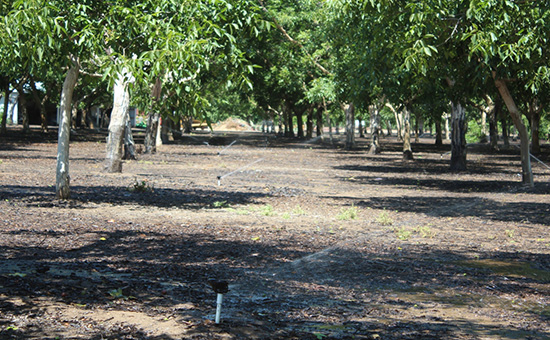 Micro-irrigation practiced by Sikh farmer in water-short Yuba City, California.
Micro-irrigation practiced by Sikh farmer in water-short Yuba City, California.
Chahal wrote, “The Ministry of Agriculture and Farmer Welfare was the nodal ministry for the NABARD-supported Rs 5,000 crore corpus fund for micro-irrigation that was made operational with the objective of providing additional resources for incentivising its adoption by different states from 2019 to 2021. It helped to expand micro-irrigation to an area of 12.83 lakh hectares involving 10.20 lakh farmers in different states, but not in Punjab.
Loans
released to Punjab by NABARD for micro-irrigation were only Rs 18.06 crs of
the sanctioned Rs 149.65 crore?
Source
States such as Andhra Pradesh, Tamil Nadu and Gujarat withdrew 100 per cent, 82 per cent and 49 per cent out of the sanctioned amount of Rs 616.13 crore, Rs 1,357.93 crore and Rs 764.13 crore, respectively.” Punjab
at 12% and Haryana at 9% were laggards. Source
Only farmers and state government can tell why Punjab has not taken to micro-irrigation like fish take to water. If farmers do not avail of opportunities that come their way, there is that much others can do.
Punjab is no longer the land of Five Rivers. Read Is Punjab the land of 5 rivers
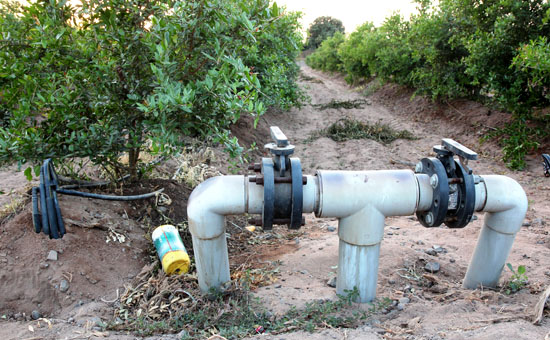 Drip-irrigation in water short Kutch, Gujarat.
Drip-irrigation in water short Kutch, Gujarat.
3. Why is
the Central government being repeatedly petitioned through protest marches to
New Delhi when Agriculture is a State subject under the Indian Constitution?
Wish someone helped with an answer. After
all, only States have a constitutional right to tax Agricultural Income!
Read Why
India needs a master class in accountability of each arm of the government?
And Solution to Farm
Distress lies with the state government
Taxing
Agriculture Income selectively is an idea whose time has come
4. Why do
Punjab farmers enjoy Free Power?
Cost of free power is app Rs 7,500
crores p.a. It leaves little resources for the state government to spend on other
farmer needs.
Around 1997-98 the Akali Dal-BJP state
government decided to provide farmers with free power. Akalis were catering to
their voter base of Jaat Sikh farmers but BJP!
Read Free
Power, MSP and Cancer
5. Why has the
Punjab government not implemented a Jyoti Gram Yojna type of scheme (separate
lines for home use and agriculture) like Gujarat did around 2005?
I wrote in 2006, “Due to inadequate power generation and excessive consumption by the agricultural sector, load shedding was unavoidable. With an investment of Rs 1,300-1,500 crore, the government decided to provide single/three-phase electricity connections to domestic and cottage industry consumers in all villages with a population more than 3,000. This way, line one is for agricultural and line two for domestic use. Homes are assured power for about 20 hours a day and the farmer gets a minimum of eight hours.”
Can Punjab replicate? This is not rocket
science. The move might stop power theft by those who use free power, meant for
agriculture, in their homes?
6. Why
Punjab has no Agri start ups?
Chahal wrote, “The Centre has raised manifold the funds meant for startups, under the scheme launched in 2016. As per FICCI-2021 report, Karnataka has the maximum number of agri startups, followed by Maharashtra, NCR, Haryana, Tamil Nadu, Telangana and Gujarat, whereas Punjab is not even taking baby steps despite suffering from large-scale unemployment among the educated youth.” Source Tribune
Chandigarh March 2022 by S S Chahal
 Punjab needs more hospitals for cancer treatment.
Punjab needs more hospitals for cancer treatment.
7. Why can
farmers not be given a legal guarantee of Minimum Support Price?
MSP was introduced in the 1960s. Noted economist Ashok Gulati told Moneycontrol.com, “The MSP works as a vital safety net for farmers, ensuring they receive equitable price for their crops, especially during periods of market volatility or when market prices fall below the MSP.”
Read What
is MSP
Senior journalist, Late Sunil Jain wrote in December 2020, “In case the MSP is guaranteed, and that will have to be for all crops and across the country – and once this is given, those growing other crops like fruits and vegetables will also demand MSP – the impact will be huge. The impact will differ from crop to crop, and even mandi to mandi, but given the difference between mandi prices and MSPs range between 20 and 50%, the cost to the government can run into several lakh crore rupees every year.” Financial
Express
Swaminathan A Iyer wrote in the Times of India of 18/2/2024, "Farmers seek implementation of a price formula suggested by the Swaminathn Commission. MSP for crops should be 50% higher than cost of production. This implies a net profit of 33.3% of Sales." Which business earns such returns.
To keep the foreign hand away, the
Centre must ensure purchase at MSP is available only to resident Indians who
are citizens of India and own agricultural land.
Read MSP
trap will bankrupt government and cripple trade And Making
MSP legal obligation can create complexities warns economist Ashok Gulati
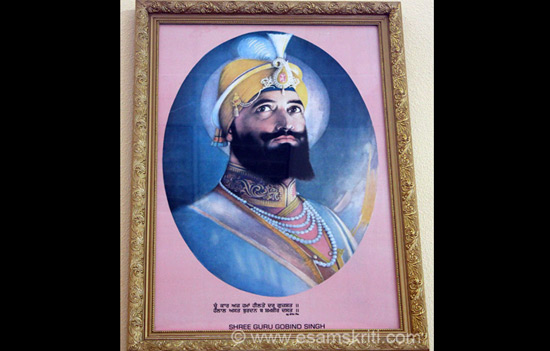 Guru Govind Singhji founded Khalsa on 30/3/1699. San Jose Gurdwara, California.
Guru Govind Singhji founded Khalsa on 30/3/1699. San Jose Gurdwara, California.
8. Was Punjab always a rice-growing region?
Punjab was a non-rice producing state till the 1970s.
The crop was grown only in some parts of the Ferozepur-Amritsar-Gurdaspur belt.
In 1961, the area under paddy was only 2.27 lakh hectares.
According to this report in Open, "Conversations with older farmers confirm how the unprecedented shift in cropping patterns – especially the dominance of paddy – has spread within the span of a generation. When we were young, paddy was sown in less than 2 per cent of the cultivable land,” says one. "Now, everyone is cultivating paddy. Earlier farmers used to cultivate, bajra, sugarcane, jowar and other fodder as well.”
We Punjabis are not rice-eaters. Rajma Chawal, Chana Chawal, Kadi Chawal is when we consume rice.
P
S Sidhu wrote (retired Senior
Agriculturist with the World Bank) in The
Tribune in 2017, “With production increasing in deficit states and per capita cereal consumption declining across all segments of the population (including poor households), India does not need Punjab's surplus rice and wheat. As inflation targeting is a stated monetary policy goal, substantial increase in the minimum support price of paddy and wheat in the future is unlikely.”
As amongst the biggest beneficiaries of MSP buying, Punjab
farmers know the days of growing rice and wheat are limited. They must realize
that the India of the 1960s and 2024 are vastly different.
India has changed, so must farmers. Sadly, the cash-strapped Punjab government (wrong
priorities) has little money to help the change, hence march to Delhi.
Read State-wise
paddy and wheat procurement under MSP
9. Why do
Punjab farmers love growing rice?
The answer lies in rice
being purchased at a Minimum Support Price declared by the central government.
MSP ensures that price at which farmer sells his produce is known and payment
guaranteed. Unlike wheat, residents of Punjab consume very little rice but the
lure of MSP is strong.
Inspite of not being in
law quantity procured under MSP is unlimited i.e. open-ended. No wonder, there
are reports of rice coming from other states to Punjab and being sold at MSP.
Read Growing
Paddy drains Punjab of its water resources
To understand how big the beneficiaries and leakages are Sidhu adds, “Appalled by a gap of Rs 20,000 crore between outstanding Cash Credit Limit and value of physical stocks with procurement agencies (which should always match), in April 2016, RBI directed the banks to classify Rs 12,000 of the outstanding food loan as non-performing asset.”
10. Why does the Khalistan issue invariably come up during
farmer protests?
Jaat Sikhs, who are the
biggest farmers - a legacy of the Punjab Land Alienation Act, 1900 were also
the biggest proponents of the Khalistani Movement of the 1980-1990s (no offence
meant).
During current protests
saw some videos on X (earlier Twitter) of Sikhs saying give us MSP or Khalistan
(we will join Pakistan). I know of many Sikhs today who are against Khalistan.
Respected Cap Amarinder Singh (former Congress leader now in BJP) said years
ago said he could not implement the Supreme Court order on the Sutlej-Yamuna
canal as it would revive the demands for Khalistan.
You see, Khalistan is a bogie today. Because of over 21,000
deaths in 1980-1990s, courts and politicians tread with caution when the K
word is used.
Read Punjab
should reform its subsidy structure, reduce dependence on MSP
To Sikhs who wish to join Pakistan say, Brothers and Sisters, see the state of Pakistan before migrating.
Read Truth
about Sikh alienation in Punjab And The
real butchers of Punjab
For those who say there
is no caste in Sikhs please read Caste
in Sikhs
11. What
about Politics in farmer protests?
Farmers, being
essentially, Jaat Sikh are the core support base of Akali Dal. Jaats have ruled
the state since it was formed in 1966. For them, agriculture is a source of
power. The state government, being AAP, would do anything to show this BJP
government in poor light.
Further, the happiness and civilizational pride post the Pran Pratistha at the Ram Mandir Ayodhya, needed to be disturbed so that BJP does not reap political benefit.
Late Sunil Jain wrote
in November 2020 This is about politics not farmer’s rights
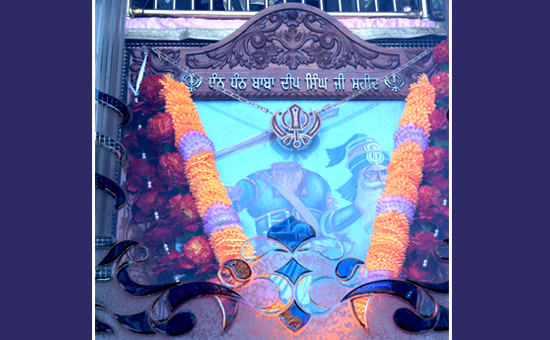 Baba Deep Singh, head cut off in fight with Jamal Khan. Holding head in hand he reached Hari Mandir.
Baba Deep Singh, head cut off in fight with Jamal Khan. Holding head in hand he reached Hari Mandir.
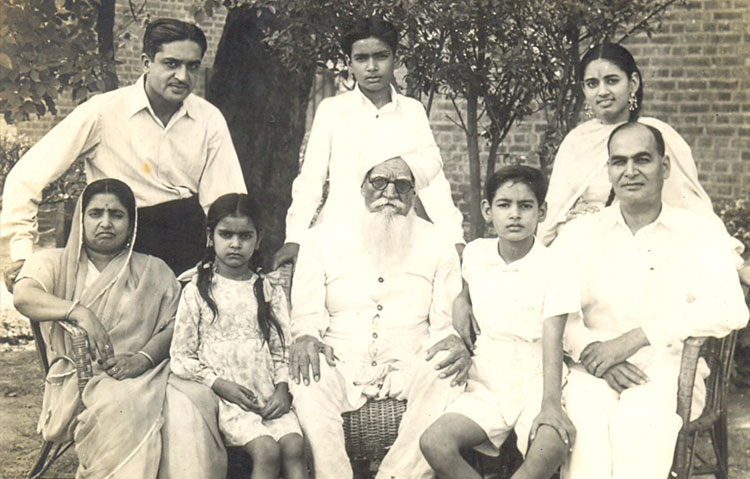 My Dadaji, his father with turban, helped re-build our lives post partition.
My Dadaji, his father with turban, helped re-build our lives post partition.
12. Farmers asking for Farm Loan Waivers?
That farm loan waivers
are bad is a no brainer.
A rational farmer would ask for: A time
bound district wise plan for increase in irrigated area, Large-scale
implementation of micro irrigation schemes, Scrapping of APMC across markets
(Agricultural Produce Marketing Committee) and Growing of crops that are
compatible with the soil.
Note that Punjab Farmers Kisan Credit Card outstanding are Rs 66,749 crs per this Tribune Chandigarh report
13. Some aggressive Punjabis lay Punjab’s claim on Bhakra Nangal Dam.
The Bhakra project was
a joint-venture between the state governments of undivided Punjab and Rajasthan
and is physically located in Himachal Pradesh/Punjab/Jammu and Kashmir today.
Read Why
was Bhakra Nangal Dam made
Machoism is part of
Punjab culture and Dilli Chalo has historical reasons. So do not get offended by such behaviour.
14. SC
stayed implementation of Farm Laws. Then!
According to this livelaw.in
report, “On October 12, 2020, SC issued notice on petitions that challenged the three farm laws. The petitions questioned the competence of the Parliament to enact the same on the ground that these were state subjects.”
Between 12/10/2020 and to date has the SC passed an order on the legality of the farm laws? The expert committee submitted their report on 19/3/2021. As on article date, has SC made report public? This inaction has compounded the problem.
15. Why Punjab farmers do not wish to diversify?
Sanjeeb Mukherjee wrote in Business Standard on 27/2/24, “The average gross returns over the actual A2+FL (input costs + own & family labour) cost of cultivation (benchmark costing used by the central government to calculate MSP) in Punjab was highest at 150.3 (Haryana 143%, Chhattisgarh 100%). Corresponding figure for wheat was 172.5%. The CACP showed that in 2021-22 98.8% of rice was procured by centre and state governments for public distribution system (West Bengal highest paddy producing state figure was 12.5%). Economist SS Johl says
reason why farmers are reluctant to shift from mono-cultivation is free power.
No crop can match paddy in terms of returns.
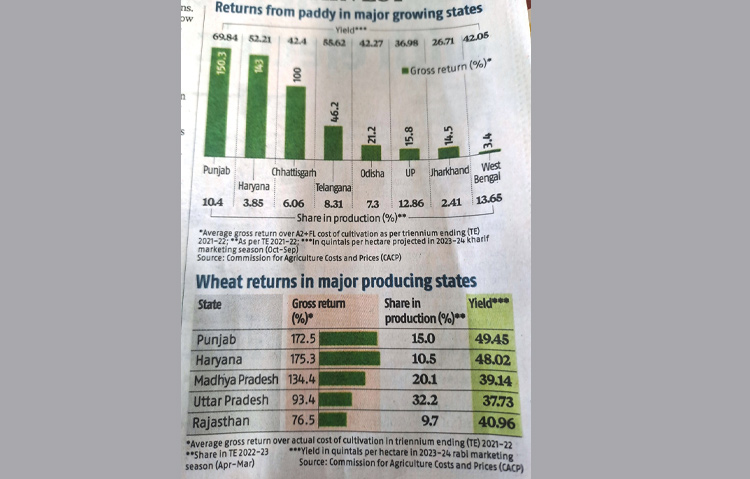 Returns from Paddy and Wheat in Key States. Note Punjab figures. Courtesy Business Standard.
Returns from Paddy and Wheat in Key States. Note Punjab figures. Courtesy Business Standard.
Farmers are reluctant to shift because of trust deficit with state government. They had promised to buy moong at MSP but later backed off.”
Financial mismanagement over decades has weakened the paying
capacity of the Punjab government. Across parties, focus is on freebies.
Punjab
has two key problems.
Resident Punjabis have
lost the risk-taking and entrepreneurial spirit. This is the same community
that re-built their lives post partition. That spirit needs revival.
Until religion and politics are
delinked, Punjabi society and politics will not be at peace.
Punjab needs a strong willed government who can effect and communicate the need for change, not to forget improved financial management.
This article should not be republished
without written approval of www.esamskriti.com.
Article pictures by author.
Also
read
1. Decoding
Scrapping of Farm Laws
2. Why Mandatory
MSP is a bad idea
3. Regulatory
Framework for NRI owning agricultural land
4. What is the
problem in Punjab
5. Damage caused by
Free Power
6. Is Punjab dying
7. Looking beyond
loan write offs for farmers